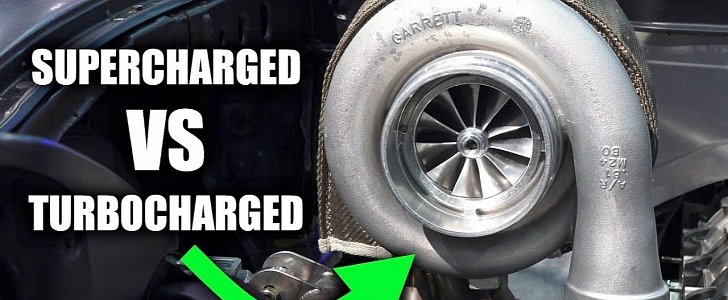Looking at today's market, you'd think the answer to the second question in the title would be simple: it's the turbochargers. Indeed, manufacturers have turned to this solution in their quest to reduce the displacement of their engines without nerfing the power output as well, so the vast majority of cars out there are using one (or more) these days.
But what are turbochargers? I think we all know Jeremy Clarkson's definition which involved witchcraft, and we probably all know the basis of what they do and even how they function. To make a long story short, they capture the exhaust gases as they exit the manifold and use their pressure to spool up a turbine.
That turbine is directly connected to another turbine which uses the twist provided by the first one to pressurize clean air and send it to the engine. More available air means more fuel can get burned, which in turn means more power. It's beautifully simple, is what it is.
The supercharger uses the exact same principle, only instead of relying on the exhaust fumes, it gets its power from the actual rotation of the engine. The thing is spinning anyway, so why not use that to power the turbine instead? It makes sense, you know it does.
So how do they differ, apart from what makes them spin? Well, we all know about one thing that's associated with turbos, and that's lag. With turbochargers, it takes a certain amount of time for things to happen, and until they do, you basically have a naturally-aspirated engine.
The lag issue is nowhere near as bad as it used to be, but it's still there for the more attentive of persons. Stemming from this is the throttle control aspect, which makes getting the right pressure on the gas pedal more guesswork than anything else.
As for the supercharged engines, they don't suffer from lag in any way whatsoever, making the driving experience a much more direct affair. They can also be tuned to deliver their boost on a wide rev range, meaning you'll get the extra oomph from very low rpms.
They only really come with one downside, and it's easy to guess which one that is based on what it is that powers the supercharger: the engine. Before they provide the kick, they need to suck up a little engine power, so while you might not feel it, it'll still affect the efficiency of the unit.
So, which is better? Well, we're afraid it all comes down to personal preference. They both have obvious advantages (no lag for the supercharger, increased efficiency for the turbochargers), so at the end of the day, it's OK if you can't make up your mind. Hey, even Volkswagen couldn't for while when it used to fit its engines with one of each, so don't lose any sleep over it.
Here is Jason Fenske from Engineering Explained giving a more rigorous rundown of the two boosting solutions in the clip below to (maybe) help you decide:
That turbine is directly connected to another turbine which uses the twist provided by the first one to pressurize clean air and send it to the engine. More available air means more fuel can get burned, which in turn means more power. It's beautifully simple, is what it is.
The supercharger uses the exact same principle, only instead of relying on the exhaust fumes, it gets its power from the actual rotation of the engine. The thing is spinning anyway, so why not use that to power the turbine instead? It makes sense, you know it does.
So how do they differ, apart from what makes them spin? Well, we all know about one thing that's associated with turbos, and that's lag. With turbochargers, it takes a certain amount of time for things to happen, and until they do, you basically have a naturally-aspirated engine.
The lag issue is nowhere near as bad as it used to be, but it's still there for the more attentive of persons. Stemming from this is the throttle control aspect, which makes getting the right pressure on the gas pedal more guesswork than anything else.
As for the supercharged engines, they don't suffer from lag in any way whatsoever, making the driving experience a much more direct affair. They can also be tuned to deliver their boost on a wide rev range, meaning you'll get the extra oomph from very low rpms.
They only really come with one downside, and it's easy to guess which one that is based on what it is that powers the supercharger: the engine. Before they provide the kick, they need to suck up a little engine power, so while you might not feel it, it'll still affect the efficiency of the unit.
So, which is better? Well, we're afraid it all comes down to personal preference. They both have obvious advantages (no lag for the supercharger, increased efficiency for the turbochargers), so at the end of the day, it's OK if you can't make up your mind. Hey, even Volkswagen couldn't for while when it used to fit its engines with one of each, so don't lose any sleep over it.
Here is Jason Fenske from Engineering Explained giving a more rigorous rundown of the two boosting solutions in the clip below to (maybe) help you decide:


